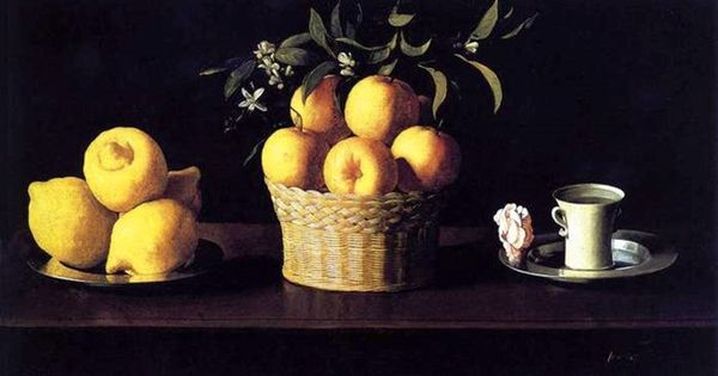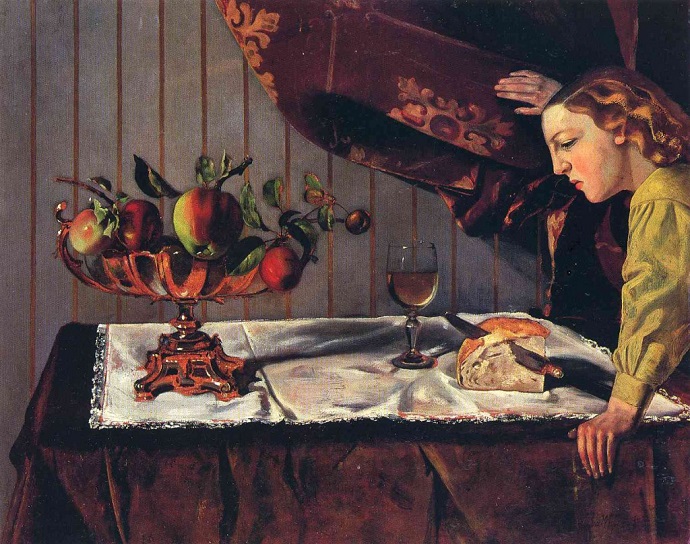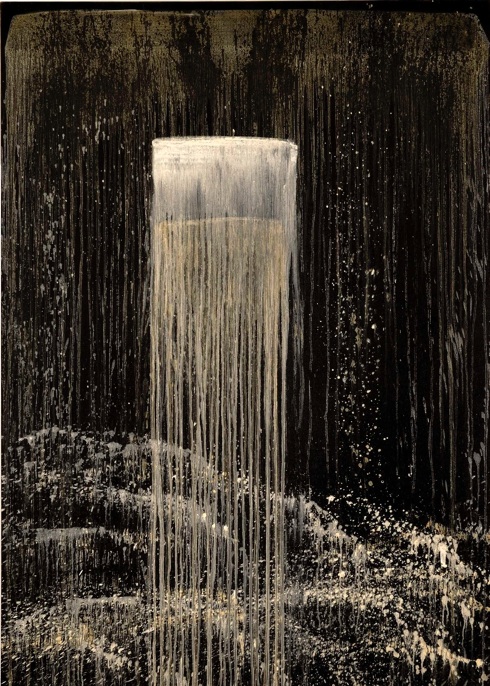|
Francisco de Zurbaran (Spanish); 1598-1664. Still Life with Lemons, Oranges and a Rose; oil on canvas; 24x42 inches.
Devout Catholics in 17th century Spain would have understood the symbolism portrayed. The careful placement of the three arrangements allude to the Holy Trinity. Also, the painting can read as an homage to the Virgin...the oranges and the blossoms along with water symbolizing her purity. The rose, which is thornless, is referencing her Immaculate Conception. Notice the humbleness of the objects. And while each occupy their own space, they reference one another...the glow emanating from them gives a strong mystical presence to the the painting. Balthus (Polish-French: 1908-2001); Still Life with a Figure (1942); oil on paper mounted on wood; 30" x 36".
Balthus never explained his paintings, leaving it up to the viewer to look and reflect. The bread and wine on the table gives a sense of the symbolism of the Last Supper in the Christian religion. Notice how the knife is pierced through the bread which can be viewed as symbolizing the crucifixion of Christ. His bowl of fruit harks back to the still life paintings of the Dutch era (1600's) whereby the objects on the table refer to the fleeting materiality of life. A young person (male or female) holds back an elaborate curtain. The scene is at one historical and contemporary. Titian (Italian: 1488-1576); Sacred and Profane Love; 1514. Oil on canvas; 3' 10" x 9' 2". Titian painted this when he was 25 years old! Much has been written about the symbolism in this painting....basically: The figure on the left with the luxurious dress represents the fleeting happiness on earth (notice how she is sitting, close to the earth) while the figure on the right who is barely clothed, holding the burning flame of God's love symbolizes eternal happiness in heaven. Cupid is in the center, stirring the waters, perhaps to show the a connection between the two, how earthly love can be the way to a more higher, purer love.
Picasso (Spanish; 1881-1973); Woman with a Veil; 1923. Oil on canvas; 39.5 " x 32". I viewed this painting in person and was struck by its ethereal beauty and simple elegance. Picasso combines painting and drawing in a manner that enhances both media.
Vincent Van Gogh (Dutch; 1853-1890): "Self-Portrait Dedicated to Paul Gauguin"; 1888. Oil on canvas, (23 3/4 x 19 1/2 in). In his correspondence with Paul Gauguin, van Gogh compared himself to Buddhist monk, “a simple worshiper of the eternal Buddha."
Lucian Freud (German born; British...1922-2011); Girl in a Dark Jacket; 1947, oil on canvas, 18.5 x 15 inches
(Portrait of his first wife, Kitty). "Freud rarely talks about his art. He almost always refused interviews and, aged 81 at the time the conversations in this book were recorded (2003-4), it had taken him his 49 year career, he says, to “know that the main point about painting is paint: that it is all about paint.” (From "The Telegraph" article: "Lucian Freud: 10 things you didn't know about his paintings") Pat Steir (American, b.1940) San Francisco Waterfall I, 1991, acrylic on canvas, (85x60 inches). Pat Steir started her "Waterfall" paintings in the late 1980's. Her meetings with John Cage and Agnes Martin (along with influences of Chinese painting traditions & techniques) guided her work in the realm of "chance" (Cage) and "magic" (Martin).
Giovanni di Paola (Italian, 1400-1482), "Creation of the World and Expulsion from Paradise" (1445, tempera & gold on wood, 18.25 x20.5 inches).
This little gem is in the Met (NY). Giovanni kept the style of the earlier medieval artists, concentrating on mysticism. Image on the right is a detail from the piece, showing a naked angel "escorting" Adam & Eve out of Paradise. It was unusual to depict an angel naked and in human form! Theories suggest that it symbolizes the angel's deep compassion for mankind's corrupted state (after the fall from grace). Click on images to enlarge. "The First Day of Creation" from the Nuremberg Chronicle. The Nuremberg Chronicle is an illustrated world history, following the story of human history as related in the Bible. Written in Latin by Hartmann Schedel ( a medical doctor, humanist, & book collector) ,it appeared in 1493. The illustrations were hand painted after printing.
|
Archives
September 2016
Categories |
Proudly powered by Weebly











 RSS Feed
RSS Feed